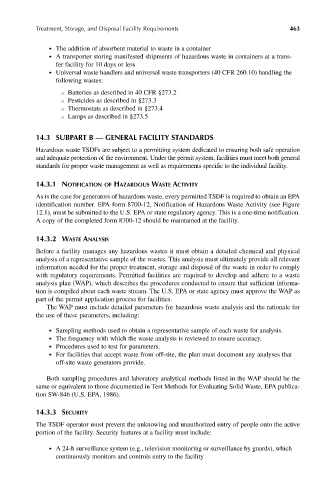Page 492 - Materials Chemistry, Second Edition
P. 492
CAT3525_C14.qxd 1/27/2005 12:37 PM Page 463
Treatment, Storage, and Disposal Facility Requirements 463
● The addition of absorbent material to waste in a container
● A transporter storing manifested shipments of hazardous waste in containers at a trans-
fer facility for 10 days or less
● Universal waste handlers and universal waste transporters (40 CFR 260.10) handling the
following wastes:
Batteries as described in 40 CFR §273.2
Pesticides as described in §273.3
Thermostats as described in §273.4
Lamps as described in §273.5
14.3 SUBPART B — GENERAL FACILITY STANDARDS
Hazardous waste TSDFs are subject to a permitting system dedicated to ensuring both safe operation
and adequate protection of the environment. Under the permit system, facilities must meet both general
standards for proper waste management as well as requirements specific to the individual facility.
14.3.1 NOTIFICATION OF HAZARDOUS WASTE ACTIVITY
As is the case for generators of hazardous waste, every permitted TSDF is required to obtain an EPA
identification number. EPA form 8700-12, Notification of Hazardous Waste Activity (see Figure
12.1), must be submitted to the U.S. EPA or state regulatory agency. This is a one-time notification.
A copy of the completed form 8700-12 should be maintained at the facility.
14.3.2 WASTE ANALYSIS
Before a facility manages any hazardous wastes it must obtain a detailed chemical and physical
analysis of a representative sample of the wastes. This analysis must ultimately provide all relevant
information needed for the proper treatment, storage and disposal of the waste in order to comply
with regulatory requirements. Permitted facilities are required to develop and adhere to a waste
analysis plan (WAP), which describes the procedures conducted to ensure that sufficient informa-
tion is compiled about each waste stream. The U.S. EPA or state agency must approve the WAP as
part of the permit application process for facilities.
The WAP must include detailed parameters for hazardous waste analysis and the rationale for
the use of these parameters, including:
● Sampling methods used to obtain a representative sample of each waste for analysis.
● The frequency with which the waste analysis is reviewed to ensure accuracy.
● Procedures used to test for parameters.
● For facilities that accept waste from off-site, the plan must document any analyses that
off-site waste generators provide.
Both sampling procedures and laboratory analytical methods listed in the WAP should be the
same or equivalent to those documented in Test Methods for Evaluating Solid Waste, EPA publica-
tion SW-846 (U.S. EPA, 1986).
14.3.3 SECURITY
The TSDF operator must prevent the unknowing and unauthorized entry of people onto the active
portion of the facility. Security features at a facility must include:
● A 24-h surveillance system (e.g., television monitoring or surveillance by guards), which
continuously monitors and controls entry to the facility

